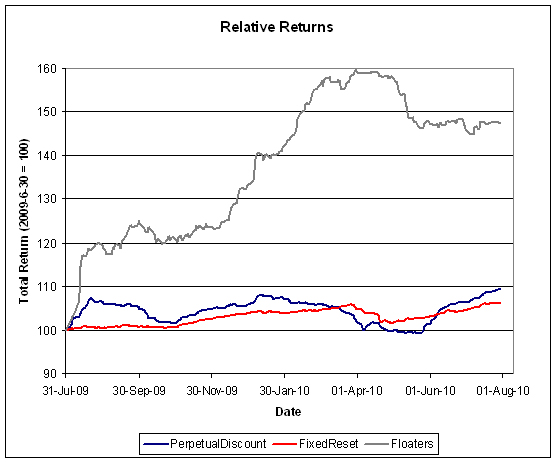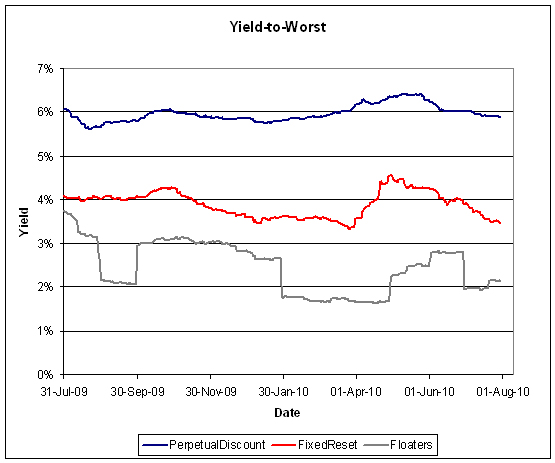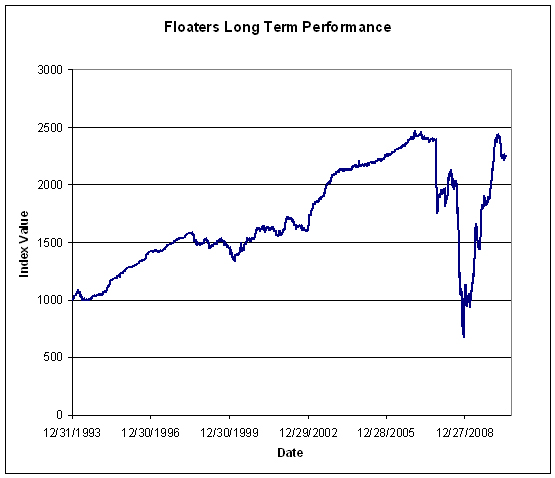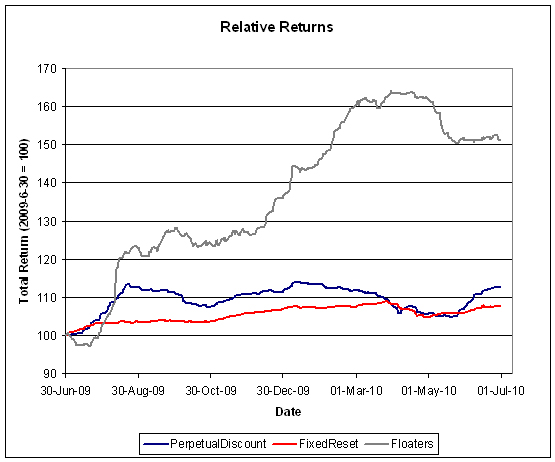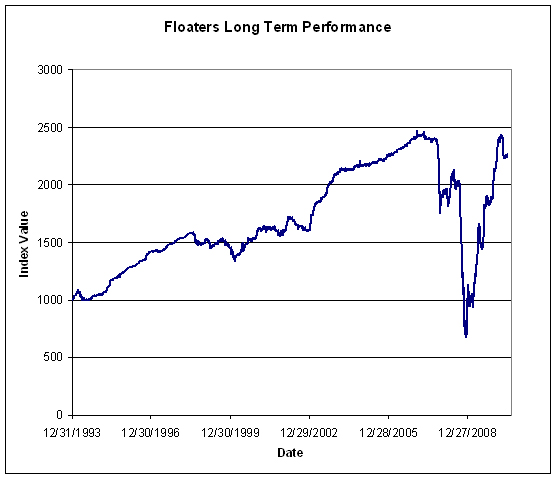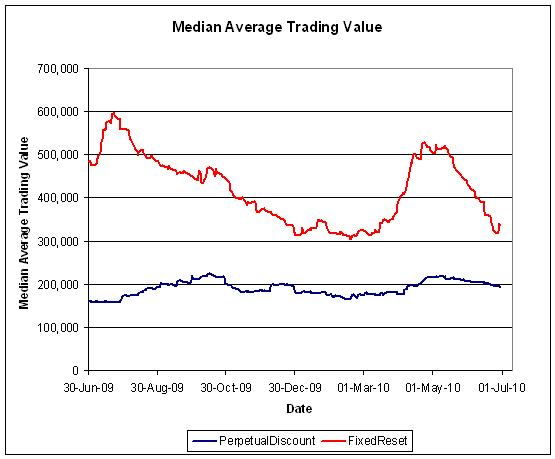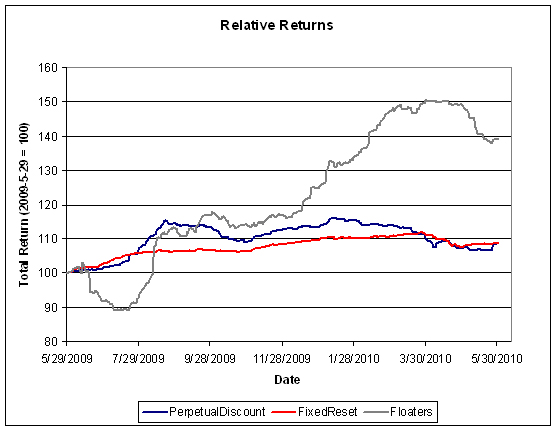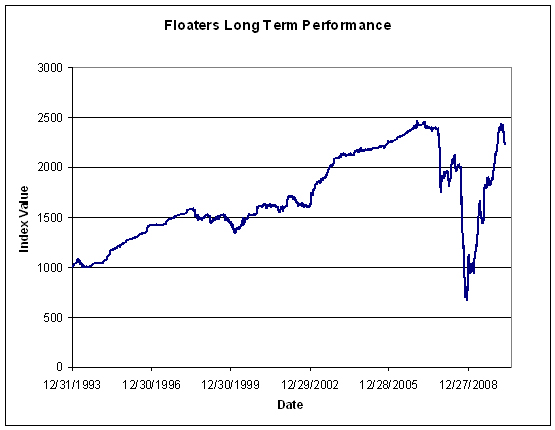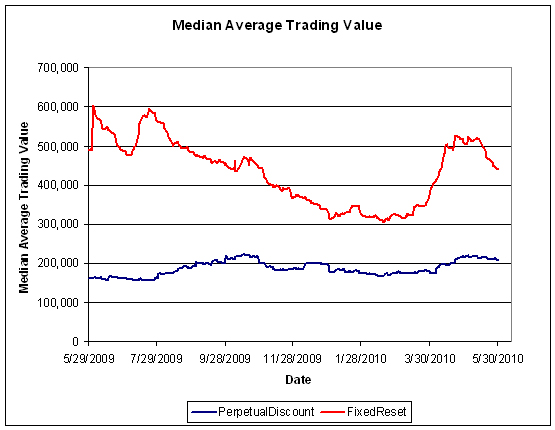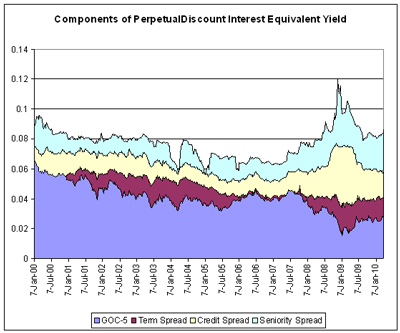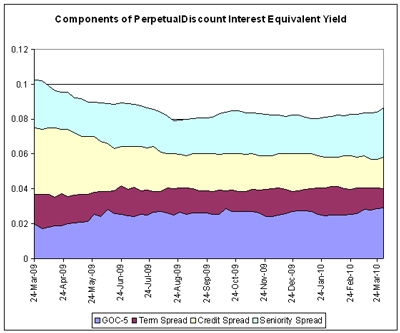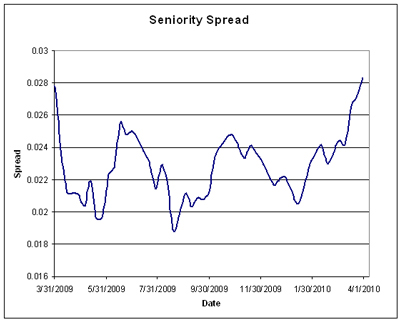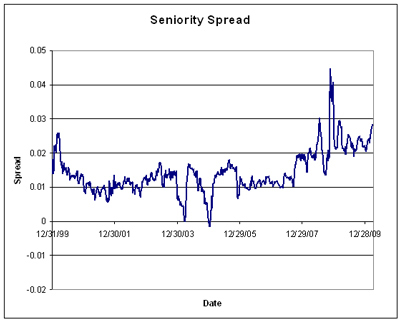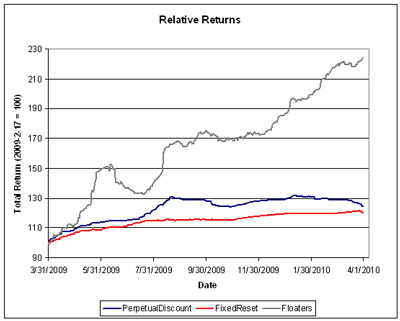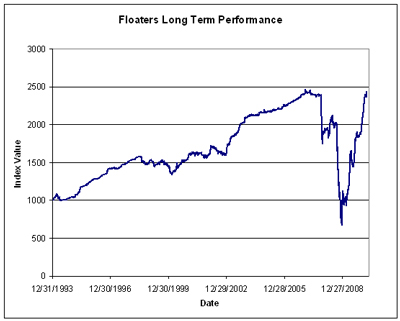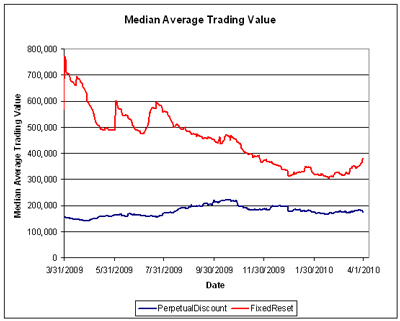Performance of the HIMIPref™ Indices for July, 2010, was:
| Total Return | ||
| Index | Performance July 2010 |
Three Months to July 30, 2010 |
| Ratchet | +1.48% | -3.04% |
| FixFloat | +0.25% ** | -2.74% ** |
| Floater | +0.25% | -6.79% |
| OpRet | +0.28% | +1.69% |
| SplitShare | +2.33% | +4.50% |
| Interest | +0.28%**** | +1.69%**** |
| PerpetualPremium | +1.09%* | +6.29%* |
| PerpetualDiscount | +2.67% | +9.55% |
| FixedReset | +1.78% | +4.71% |
| * The last member of the PerpetualPremium index was transferred to PerpetualDiscount at the May, 2010, rebalancing; the June performance is set equal to the PerpetualDiscount index; the index was repopulate (from the PerpetualPremium index) at the June rebalancing. | ||
| ** The last member of the FixedFloater index was transferred to Scraps at the June, 2010, rebalancing; subsequent performance figures are set equal to the Floater index | ||
| **** The last member of the InterestBearing index was transferred to Scraps at the June, 2009, rebalancing; subsequent performance figures are set equal to the OperatingRetractible index | ||
| Passive Funds (see below for calculations) | ||
| CPD | +1.57% | +5.16% |
| DPS.UN | +2.05% | +5.77% |
| Index | ||
| BMO-CM 50 | +1.87% | +5.11% |
| TXPR Total Return | +1.70% | +5.40% |
Unofficial data for TXPR indicates a total return of +1.70% for July, indicating a rather large tracking error of 55bp for CPD on the month, probably due to the semi-annual July rebalancing. No accounting had been made in the original post for the change to monthly distributions. This error has now been corrected. The tracking error for July is therefore 13bp – still rather large, but much smaller than the estimate that did not account for the distribution.
The pre-tax interest equivalent spread of PerpetualDiscounts over Long Corporates (which I also refer to as the Seniority Spread) ended the month at 275bp, a significant decline from the 290bp recorded at June month-end. Long corporate yields increased slightly, to 5.5% from 5.45%. I would be happier with long corporates in the 6.00-6.25% range, but what do I know? The market has never shown any particular interest in my happiness.
Charts related to the Seniority Spread and the Bozo Spread (PerpetualDiscount Current Yield less FixedReset Current Yield) are published in PrefLetter.
The trailing year returns are starting to look a bit more normal.
But I suggest that eventually yields will make a difference:
Floaters have had a wild ride
FixedReset volume declined during the month after their burst of activity in April when they performed poorly. Volume may be under-reported due to the influence of Alternative Trading Systems (as discussed in the November PrefLetter), but I am biding my time before incorporating ATS volumes into the calculations, to see if the effect is transient or not.
Compositions of the passive funds were discussed in the September, 2009, edition of PrefLetter.
Claymore has published NAV and distribution data (problems with the page in IE8 can be kludged by using compatibility view) for its exchange traded fund (CPD) and I have derived the following table:
| CPD Return, 1- & 3-month, to July, 2010 | ||||
| Date | NAV | Distribution | Return for Sub-Period | Monthly Return |
| April 30 | 16.11 | |||
| May 31 | 16.26 | +0.93% | ||
| June 25 | 16.47 | 0.21 | +2.58% | +2.58% |
| June 30, 2010 | 16.47 | 0.00 | 0.00% | |
| July 27 | 16.62 | 0.069 | +1.33% | +1.57% |
| July 30, 2010 | 16.66 | 0.00 | 0.24% | |
| Quarterly Return | +5.16% | |||
Claymore currently holds $462,433,680 (advisor & common combined) in CPD assets, up about $18-million from the $444,847,391 reported last month and up about $88-million from the $373,729,364 reported at year-end. The monthly increase in AUM of about 3.95% is larger than the total return of +1.15%, implying that the ETF experienced net subscriptions in July.
The DPS.UN NAV for July 28 has been published so we may calculate the approximate July returns.
| DPS.UN NAV Return, July-ish 2010 | ||||
| Date | NAV | Distribution | Return for sub-period | Return for period |
| June 30, 2010 | 19.85 | |||
| July 28, 2010 | 20.21 | +1.81% | ||
| Estimated July Ending Stub | +0.24% ** | |||
| Estimated July Return | +2.05% *** | |||
| **CPD had a NAVPU of 16.62 on July 28 and 16.66 on July 30, hence the total return for the period for CPD was +0.24%. The return for DPS.UN in this period is presumed to be equal. | ||||
| *** The estimated July return for DPS.UN’s NAV is therefore the product of two period returns, +1.81% and +0.24% to arrive at an estimate for the calendar month of +2.05% | ||||
Now, to see the DPS.UN quarterly NAV approximate return, we refer to the calculations for May and June:
| DPS.UN NAV Returns, three-month-ish to end-July-ish, 2010 | |
| May-ish | +0.22% |
| June-ish | +3.42% |
| July-ish | +2.05% |
| Three-months-ish | +5.77% |
